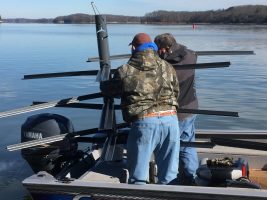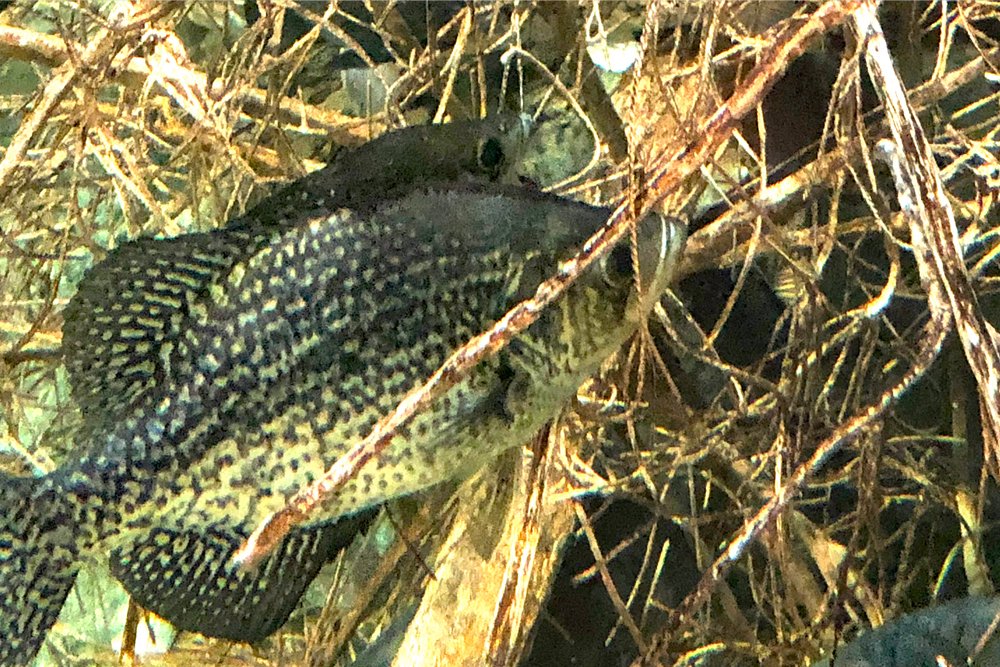Sometimes you can catch them in open water, but it is no secret that in general, crappie prefer
having their noses buried in a brush pile. And if you know exactly where those brush piles are,
it increases your crappie-catching odds tremendously. (Photo: Richard Simms)
Build Your Own Ace in the Hole
by Steve McCadams
The principal behind building fish attractors is really quite simple. The goal is bringing the fish and the fishermen closer together.

The war on crappie will always have a long grocery list of “what to do and how to do it” questions. However, wise are the anglers who build their very own fish attractors, taking a lot of the guess work out of the equation. Instead of launching at the boat ramp and wondering where to start in a vast body of water – be it a relatively small lake or massive reservoir – having an abundance of man-made fish attractors will put you in the driver’s seat for finding and catching more crappie.
Crappie have long had the reputation of being “structure oriented” fish. They seek cover during the spring spawn to broadcast their eggs on submerged hideouts. But throughout the year they also relate to cover for safety and food.
Even the slow trolling armies of long-liners, spider riggers, crankbait pullers and wind drifters know their routes need to be around or over areas where submerged structures below help hold the crappie within a zone.
Although the fish may sometimes suspend in la-la land, they’re often holding in an area where some sort of cover nearby provides a comfort zone.
Here’s some tips for creating those comfort zones. Of course, always check the local regulations for placing your own fish attractors and by all means, avoid creating any navigation hazards.
Stakebeds and Brushpiles

It is always easiest to build your structures on dry land first. such as treetops, stakebeds or wooden slabs framed in wooden squares, various PVC plastic pipes or other such material set in concrete. By erecting them on shore you can mass produce structures that are small enough to handle and lift into pontoons or jon boats for distribution out on the lake.
Some anglers drive a series of wooden slabs or tomato type sticks into the lake bottom. This forms a matrix for crappie to hide around and ambush the shad. Algae and plankton form around the structure and help draw baitfish too. Guess who’s not far behind?
It’s a good idea to scout the specific areas you plan to fish by either mapping or establishing waypoints on your GPS units. Utilize a floating buoy marker to pinpoint the spot before returning to sink the structures. Take into account the wind as you’ll drift once you get ready to toss them overboard.
Prior to actually dropping the fish attractors, do your best to select spots based on depth. Some reservoirs have a wide range of fluctuation between winter and summer. Take this into account.
It’s really not complicated but remember to closely observe topographical maps and sonar information. If you locate ledges where two depth extremes come close together or perhaps encounter long sloping points extending out away from shorelines remember this: put several structures out and apply them to several depth ranges.
Place some on the deep side of a ledge close to the break but also put some up on the edge of the drop-off itself. Then, to cover all the bases place a few up on the shallow side. The efforts are both spawning habitat and refuge for young of the year plus a comfort zone for larger fish throughout the year.
Another tip in placement of structures is to take into account nasty winds. All crappie anglers battle wind at times so respond to that challenge by sinking some beds in an area shielded from relentless northeast winds or high southwest breezes, etc.

They don’t come cheap, but manufactured PVC fish attractors are extremely effective and if placed properly, will last for years and years. The attractor these anglers are placing came from American Fish Tree (americanfishtree.com). Mossback Fish Habitat (mossbackfishhabitat.com) also manufactures excellent fish attractors. (Photo: Richard Simms)

During the winter when his local lake levels are lowered, Shawn Hines dons waders to drive stakes into the bottom. He will return after lake levels rise in the spring and likely find crappie hiding among his stakes. (Photo: Richard Hines)

Any boat can be used to sink the fish attractors you’ve built on shore. McCadams, however, says a roomy pontoon boat can make the task much easier and more efficient.
Ask yourself, “If there are whitecaps on the lake,” where would I want to go hide and still be able to fish?” Then plan your bed placement accordingly. That way you will still have some targeted spots while other boats are roaming randomly in the wind.
Building your own fish attractors is hard work. Doing it right usually won’t happen in just a few hours. Between finding materials, building and placement – think more in the matter of days.
However, having done it to make my living for 45 years, I can attest to their success.
Tend your own crappie garden and you will soon discover that fish attractors are indeed your “Ace in the Hole.”
Steve McCadams is a professional guide and outdoor writer from Paris, Tenn. near Kentucky Lake. A member of The National Fresh Water Fishing Hall of Fame and Legends of the Outdoors he’s been under the spell of the great outdoors for more than 60 years.


